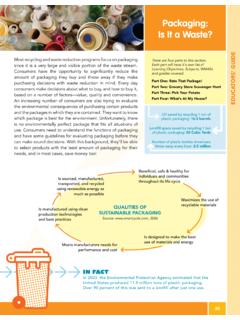Transcription of Why Tomatoes Take Their Sweet Time to Ripen
1 Why Tomatoes Take Their Sweet Time to Ripen by Joe Lamp'l Reprinted with permission. Copyright 2009 Gardener News, September, 2009. I've been hearing from many impatient gardeners lately. They all have the same question;. My Tomatoes are big and green on the vine, but they just don't seem to be getting ripe. They're just sitting there! What's happened? . Under normal conditions, from the point of flower fertilization, it takes just under two months until the tomato fruit should reach full maturity. And if you stop to think about it, tomato plants have a lot going on all at the same time.
2 While they are producing and ripening fruit, the plants are still putting on new growth, developing more extensive root systems and producing components for color and flavor, all in an effort to support existing and newer fruit yet to come. Fortunately, tomato plants are equipped to handle this multi-tasking quite well. When conditions are ideal, such as a favorable climate and plenty of spring showers and moderate summer temperatures, tomato plants thrive and the harvest is bountiful. However, these days, perfect conditions seem to be less and less of a reality.
3 More often, typical spring weather, so pleasing to tomato plant growth and fruit set, all too quickly evolves into the overly hot, dry days of summer to which we are becoming more accustomed. The mild conditions that resulted in rapid growth and a plethora of vine-ripening fruit have changed such that tomato plants are now faced with demands that require some redirection in how Their energy is distributed. The key resource needed to produce the food energy responsible for healthy plants and ripe Tomatoes starts with sufficient leaf surface. When the plant becomes laden with fruit, additional foliage surface area is required to keep up with these increased demands.
4 The plant is now called upon to spread its energy in a multi-tasking balancing act that becomes even more demanding as the season wears on, even into September. Even though the tomato fruit reaches full size in about 25 days, it doesn't completely Ripen until sufficient compounds are present to give it the color, taste and texture we love. And with over 400 of these compounds building together into a crescendo of perfection, that won't happen until conditions are again in balance. Air temperatures above 85 degrees are one of the most common reasons Tomatoes don't Ripen as fast as you might expect.
5 When temperatures rise above this level, Tomatoes stop making carotene and lycopene pigments, two of the most important and recognized components in the symphony. Below ground, temperature is just as important. The roots require soil temperatures below 80 degrees for optimal growth. So as temperatures rise, one of the first responses is for shallow-rooted tomato plants to develop a deeper, more robust root system, further diverting and delaying precious fruit ripening energy. If you can't wait for Mother Nature, there is something you can do to try and speed up the process.
6 If the plant is laden with fruit, you might want to consider removing some of the smaller, misshapen or imperfect ones. With fewer Tomatoes , there is less demand on the plant. Therefore, more energy can be concentrated on ripening the remaining fruit, when Mother Nature gives the signal to resume. You might also think it makes sense to add some extra fertilizer at this time to give those Tomatoes a little extra boost. But don't do it. The environmental changes that result in this slowdown are nature's way of dealing with and resolving the challenge.
7 The typical delay is not related to a nutritional deficiency. In fact, adding fertilizer now could exacerbate the problem by forcing the plants into a growth mode at an inappropriate time. Tomato plants are quite adaptable and they will adjust to environmental changes in time. All that is required of you is patience and possibly some supplemental water with a good layer of mulch to help moderate soil temperatures. Consider it delayed gratification. You will be rewarded for your patience!









